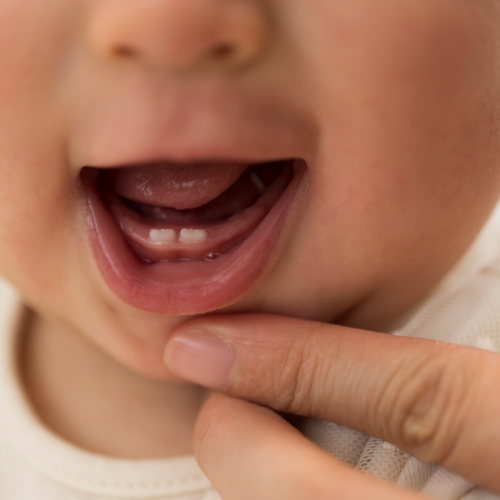The article uses information from the American Dental Association, the American Academy of Pediatrics, the National Institutes of Health and more (see sources below) to explain the most common teething symptoms in toddlers. While most babies will start teething before they are toddlers, their full set of permanent teeth isn’t in until they are between 2 and 3 years of age – smack dab in the toddler years.
Below we review what symptoms are most common as kids get a new tooth, based on available evidence (and what are old wives tales), the typical age when teeth are coming in and in what order, plus a few lesser known facts about how kids teeth develop.
Teething Symptoms in Toddlers, Backed by Evidence
There’s been a long debate among parents and health care professionals over just what symptoms come along with teething. A 2016 American Academy of Pediatrics study said the topic been “extensively studied but it is still controversial,” and aimed to put an end to the back and forth.
Researchers went through nearly 1,200 articles and identified 16 high quality studies, with a total of 3,506 children evaluated, that could be statistically compared. They found that the following symptoms were the most common reported by health care professionals among children who were teething (percentages are rounded up):
- Gum irritation (sore gums) — 90%
- Irritability – 70%
- Excessive drooling – 60%
- Sucking finger — 40%
- Loss of appetite — 35%
- Agitated sleep — 30%
- Runny nose — 30%
- Fever — 25%
- Diarrhea — 15%
- Face rash — 5%
Ultimately, the authors concluded that irritated gums and drooling were the most common, and that there was statistical evidence for “biting, drooling, gum rubbing, irritability, sucking, sleep awakenings, ear rubbing, rash on face, decreased appetite for solids, and slight temperature elevation.”
The emphasis on slight temperature elevation is important. The data showed that teething “is associated with a rise in temperature, but it was not characterized as fever.” In other words, the elevated body temperature did not go above 100.4 degrees. (Want to know more about fevers and what it means if your child has a fever but no other symptoms? Check out our article here.)
If your child has a high fever (or just a fever in general), health professionals caution that you should not chalk it up to teething and hope it goes away. Keep an eye out for other symptoms, and keep in mind that fevers that don’t have other accompanying problems can be a sign of an ear infection, or in girls, a urinary tract infection. (More details here.)
When Kids Actually Get Their Teeth – It Takes Years!
There wasn’t a ton of evidence on how symptoms for teething change with age. But (some good news, parents!) the authors of the Pediatrics study wrote that “it seems that symptoms…decrease with age.”
Exactly when do those teeth come in? Below are the common ages kids get their first teeth, according to a study in the Pediatric Clinics of North America. Bottom line, kids are still getting plenty of teeth after their first birthday but are often done teething by their third birthdays. (Permanent teeth typically start coming in around 5 or 6 years of age).
Front teeth:
- Bottom – 8 months of age
- Top – 10 months
Lateral front teeth (teeth on the outside of the front teeth):
- Bottom – 13 months
- Top – 10 months
Canine (pointy teeth in the front):
- Bottom – 20 months
- Top – 18 months
First molars:
- Bottom – 15 months
- Top – 15 months
Second molars:
- Bottom – 2 years of age
- Top – 2.5 years of age
How to Help Kids Who Are Teething (No Teething Necklaces, Tablets, or Gel Please!)
The American Dental Association and American Academy of Pediatrics recommends the following things to make your child more comfortable as they are teething:
- Massage — Gently rub your child’s gums with a clean finger, a small cool spoon, or a moist gauze pad
- Chew toy — Give your kid a clean chew toy or teething ring, preferably made of solid rubber and NOT liquid-filled or a plastic that could break in baby’s mouth (no amber, wood, marble!)
- Washcloth – Give your child a damp washcloth that has been “twisted and frozen (tie one end in a knot for better gnawing).” (Note: The AAP says to “avoid teething rings that are frozen solid; they are too hard for children’s mouths.”)
Both groups do NOT recommend medications that are rubbed on your baby’s gums or your toddler’s gums. That’s because your child is likely drooling so much the medicine will be washed away and can end up numbing the back of your child’s throat, making it harder to swallow. (And note that anything with benzocaine is not recommended for infants.)
In addition to avoiding medications, the American Academy of Pediatrics warns against teething necklaces. In 2018 the Food and Drug Administration (FDA) issued an official warning after children choked on beads that break off and an 18-month-old was strangled to death by an amber necklace during a nap.
Bottom line, the necklaces are a choking hazard and there are serious risks that come with using them. The AAP also reports that Dr. Andrew Weil, “a world-renowned leader and pioneer in the field of integrative medicine” says “the use of these necklaces is not supported by modern science.”
Lastly, the FDA also cautioned parents to get rid of of homeopathic teething tablets, after lab testing found “inconsistent amounts of belladonna, a toxic substance, in certain homeopathic teething tablets, sometimes far exceeding the amount claimed on the label.”
Take Care of Those Baby Teeth
The American Dental Association explains that it’s important to take care of your child’s baby teeth, even though they will fall out in a few years. That’s because they “help set the proper spacing for adult teeth to come in correctly — a process that starts around age 6.” If your child loses baby teeth due to tooth decay, the ADA says it can “threaten the health of your child’s permanent teeth.” They recommend the following care:
“As soon as baby teeth appear, gently brush them twice daily with a small, soft-bristled brush and a little fluoride toothpaste (about the size of a grain of rice). You’ll need to brush your child’s teeth at first, gradually helping them learn how to brush as they grow.”
SOURCES
NORMAL FORMATION AND DEVELOPMENT DEFECTS OF THE HUMAN DENTITION – ScienceDirect
Teething | MouthHealthy – Oral Health Information from the ADA
Signs and Symptoms of Primary Tooth Eruption: A Meta-analysis – PubMed (nih.gov)
Baby Teething Pain – HealthyChildren.org
Teething Necklaces and Beads: A Caution for Parents – HealthyChildren.org
Baby Teeth | MouthHealthy – Oral Health Information from the ADA


